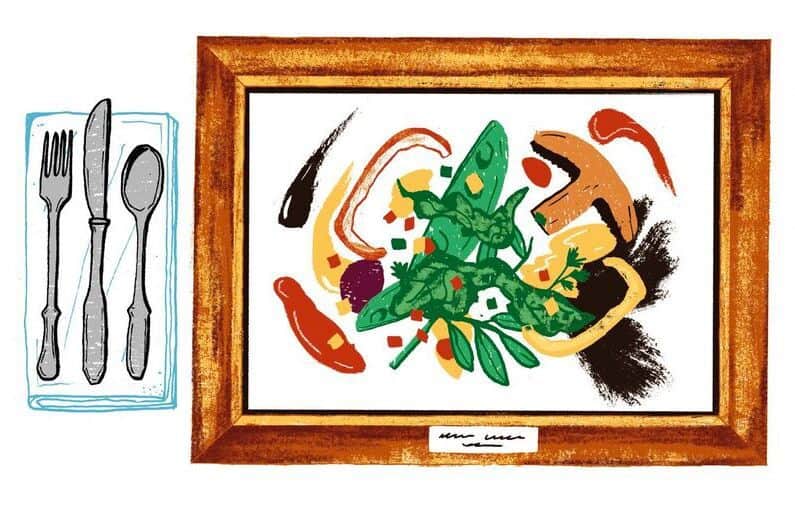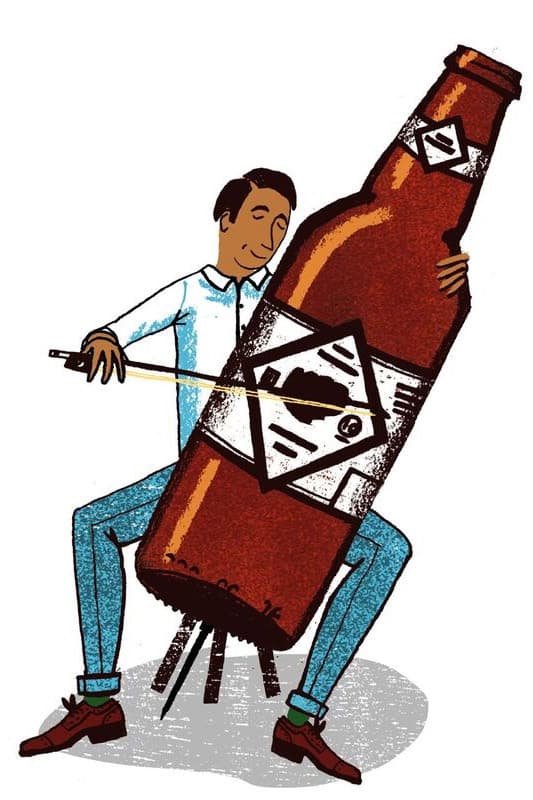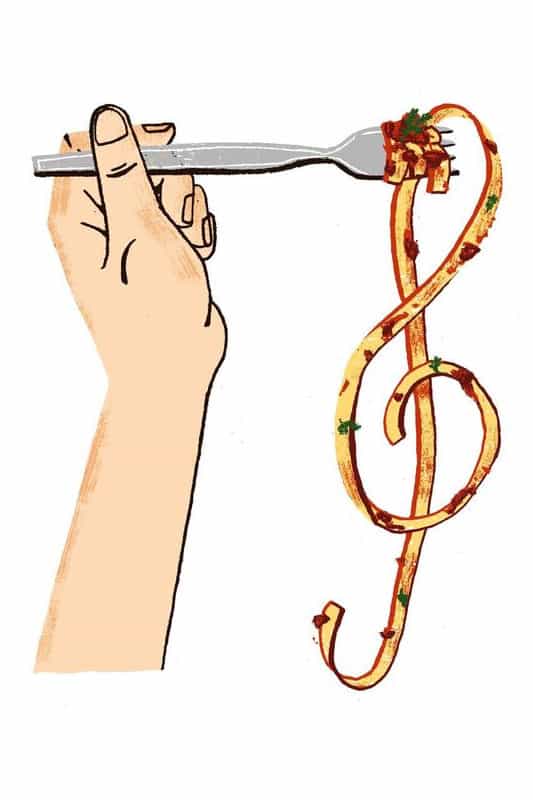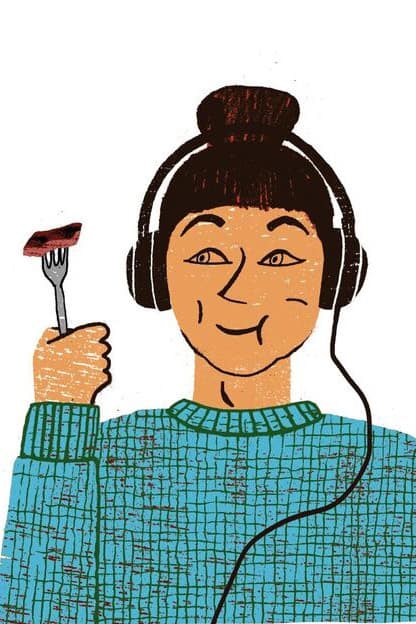
There are a few historical precedents for food and sound pairings: a 15th century French duke who surprised court guests with 28 musicians squeezed into a pie; wheels of Austrian Grottenhofer Auslese cheese maturing alongside a constant stream of Gregorian chanting. But for the most part, it’s a new idea. Its seeds are being sown in moments of epiphany among curious minds: Adapting to dining solo, a recent divorcée dons headphones while eating a steak; a psychology professor ponders the crunch of Pringles while drinking at a bar; a video game music composer imagines an asparagus opera; a group of senior citizens discovers Coolio while eating lava cake.
Food + Music
My own epiphany involves a hoppy brown ale and a cello. I’m huddled around an art gallery stage at an event hosted by Original Gravity, a Boston-based non-profit that promotes local composers by pairing their music with beer. For tonight’s concert, neighborhood brewers have concocted suds inspired by specific songs. The crowd sips samples from the evening’s flight as musicians perform.

One song, “Dionysian Dance” by David Cucchiara, is mesmerizing. It’s melancholy but energetic, the warm, silky tones of its legato strings juxtaposed with a deep plucking. The beer, made at nearby Bone Up Brewing Co., is cloudy and brown, sweet initially but with a bitter, woodsy undertone. The experience is hard to describe. As I listen and sip, that bitterness seems amplified by the cello’s sonorous hum—like a secret being revealed. Later, I ask the brewer, Jared Kiraly, what he and co-owner, Liz Kiraly, aimed to express in the drink. “The song reminded us of excited conversations engaged in hushed conspirational tones,” he says.
Sounds about right. But I wonder how it all worked—are my ears and taste buds in cahoots, or is my brain playing a trick on me? In search of an answer, I turn to the wine world. As a psychologist and competitive wine taster, Oxford University researcher Janice Wang has spent years studying wine and music pairings. She tells me that it follows the same principles as wine and food: Just as we pair big reds with bold dishes and delicate whites with lighter plates, the cabernet sauvignon begs for a full orchestra, while a mineral-y riesling fits with ethereal harp.
Wang explains that sounds can also draw out different aspects of flavor—high pitches promoting sweetness, low pitches accentuating bitterness, high tempos boosting sourness. “If I want to bring out fruity or acidic notes in a wine, I’ll pair it with music that’s more high pitched, or faster,” she says. “If I want to bring out the deeper, darker dried fruit or chocolate notes, then I probably want something lower-pitched, like cello.” No surprise what the cello did to my brown ale, then; Wang says the same principles apply to other music pairings, from symphonies and beer to R&B and cheese.
“If I want to bring out the deeper, darker dried fruit or chocolate notes, then I probably want something lower-pitched, like cello.”
Flavor + Science
Wang’s claims are backed up by solid evidence compiled by her colleagues at Oxford’s Crossmodal Research Laboratory. The lab, run by psychology professor Charles Spence, studies how multiple senses interact to generate experience.
Spence didn’t always work with food. In the early 2000s, he was studying the “parchment skin illusion,” the idea that muffling the sound of one’s hands rubbing together upped the perception of their softness. One night at a bar, as he eyed some potato chips, the thought struck: Why not test the same principle—sound’s impact on touch—in the context of eating?

Spence recruited volunteers willing to eat 200 Pringles in front of a microphone while rating each chip for freshness and crispness. As subjects bit in, he fed real-time crunching sounds into their headphones, toying with pitch and volume. Although all chips were the same, subjects rated them differently: Higher crunching sound volume and pitch were associated with greater freshness rating. In other words, sound influenced tactile sensation—and the pleasure of eating.
I’ve always thought of my brain as a kind of walkie-talkie that receives transmissions directly from my senses. (“Come in, brain,” says the nose, “those chips are delicious.” “Alert, brain,” says the ears, “you like that song.”) But the lab’s research reveals that the signals are a bit more jumbled, exhibiting a kind of co-channel interference in the subconscious.
Some of the most curious jumbles relate to taste and sound. The researchers have found that in the presence of airplane noise, subjects find the sweetness of food diminished and umami elevated; when listening to low-pitched music, toffee becomes more bitter; different styles of music can up the sweetness or the creaminess of chocolate. Other cross-communications reveal the influence of texture, weight, and imagery. For instance, subjects rate cake eaten off a round (rather than square) plate as sweeter; a cookie seems crunchier when served on a rough-textured dish; yogurt is judged denser and more expensive when tasted with a lightweight spoon; a bite tastes saltier when sampled off a knife.
Given those revelations, is it so difficult to imagine a future in which the art of the pairing extends beyond food? Not at all. It’s already here.
In other words, sound influenced tactile sensation—and the pleasure of eating.
Science + Art
Connecticut-based entrepreneur Barbara Werner didn’t need a university lab to point out the connection between sound and taste. Navigating the unfamiliar landscape of solo dining following a divorce several years ago, she tried listening to music on her headphones during a steakhouse dinner. It was the best steak she’d ever had, she says—until the track changed. “I was drooling over this thing, sawing at it,” she says. “Then all of a sudden, that gorgeous steak was just a piece of meat.”
Determined to understand why, Werner began keeping tabs on every meal (cooking method, protein density, sauce type, spice level), plus her favorite song to eat it by (tempo, primary instrument, amplitude, frequency). Over time, she created a point system based on emerging patterns. To find the perfect pairing, she matches the number of points in a meal to a song with the same number. Her company, Musical Pairing, built the formula into a smartphone app and tested it in popup dinners around the country. Werner’s most successful combination? A chocolate lava cake alongside “Gangsta’s Paradise.” “I’ve had 70-year-old women rocking out to Coolio because we were eating a rich cake,” she says.

Werner isn’t the only entrepreneur bringing musical pairing to the masses. When I meet composer Ben Houge, he’s exhausted from curating an event at Boston’s Symphony Hall the night before: a “food opera” that combined the overture to Étienne Méhul’s Les Amazones with dinner. There, diners sipped creamy mushroom soup alongside a smooth cello. They also enjoyed blue cheese crème brûlée during a musical number with shorter, contrasting phrases. (Houge had found a correlation between the bracing music and the blue cheese, both being “sort of aggressive…but rewarding when you get used to it.”)
Since his first public event in 2012—a collaboration with Boston chef Jason Bond to create a four-course “asparagus opera”—Houge has been designing similar experiences, with an approach that differs markedly from that of Werner. With a background as a video game music composer, he sees fine dining much like a virtual world, or a film: a space where sound can be tweaked to bring out aspects of a meal. Like video game players, diners navigate each meal in unpredictable ways, and Houge is focusing on incorporating technology—from iPads to responsive dishware—that helps synchronize evolving sounds with a meal’s pace.
He sees fine dining much like a virtual world, or a film: a space where sound can be tweaked to bring out aspects of a meal.
Though drawing inspiration from science, Houge’s food operas are less about rigorous experimentation and more about aesthetic experience. When it comes to the human senses, he tells me, artists typically focus on sight and sound, relegating taste and smell to the realm of basic and animalistic. “People are now questioning those assumptions in interesting ways,” he says. “Artists are looking at what we can communicate with taste and the chemical senses. At the same time, chefs are starting to think about the theatrical potential of a meal.”
One such chef, Charles Michel, worked in Michelin-starred restaurant kitchens in France and Italy before reinventing himself as an artist. His chosen medium was food, and after his “salad painting” caught the eye of Charles Spence, Michel was invited to the Oxford lab, where he spent three years exploring food aesthetics. Today he is designing utensils based on lab findings to enhance eating pleasure.
To Michel, all of this is based on one fundamental pairing: that of art and science. “Art communicates beauty and meaning, and science is what gives us evidence to understand how to make more beauty and more meaning,” he says. “By combining both, we can come up with innovations that maximize the enjoyment we get from food.” While there’s still plenty of mystery surrounding the interaction of senses in the brain, the goal among “crossmodalists” like Michel is to connect people to their own senses, expanding mindfulness in an age of harried eating.
Back at the beer and music event, one performance stands out. So far the night’s pairings have been unanimously based on similarity, until a song called “Rise of a City” begins. It’s a noisy, urgent number performed on an electric guitar and a robot-manned percussion set, paired with a maple syrup lager aged in bourbon oak. It feels disjointed; the song transports me to an industrial dystopia, while the beer recalls a resinous forest.
Turns out, the clash is the point. “Electronics versus maple trees…the idea is to contrast,” explains Cambridge Brewing Company’s brewmaster Will Meyers of his choice, “to embrace the areas where contemporary society and nature overlap.” Perhaps it’s like pairing a dense, salty cheese with a sweet, flowing honey; some of the best combinations are based on contrast. Does the same principle apply outside of food? We’re still figuring it out, but maybe that’s the whole point: A pairing works when it makes us think.
The Brie en Croûte Experiment
To illustrate Musical Pairing, Barbara Werner tells me to try a bite of brie wrapped in pastry dough with some fig jam (“My favorite thing on Earth,” she says). Per her formula, we add four points for a soft cheese, one point for the sweet fig jam, one point for the cow’s milk, and two points for the pastry, for a “food pairing number” (FPN) of eight.
“So, you’re going to look for music that’s also an eight,” she says. She thinks out loud, detailing traits that could yield that high of a number: “something with a mellow beat, lower volume, tenor voice.” Her suggested pairing? “Dream a Little Dream of Me” by Michael Bublé, or “Midnight Rider” by the Allman Brothers.
To prove the point, Werner suggests mixing it up. “Try having the brie alone, with crackers. It’s going to be much lighter because you won’t have the pastry,” she says. “You can still have the Allman Brothers, but instead, play ‘Ramblin’ Man.’”
The “musical pairing number” (MPN) matters irrespective of genre, she adds: “You could play Eminem’s ‘The Monster’ with Rihanna and it will still enhance the brie.”
Want more about the science of taste? Explore the ways aroma science is shaking up food pairings, too, or learn a little bit about food pairing theory.
Illustrations by Tom Jay



